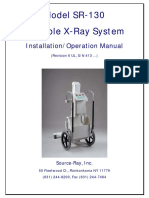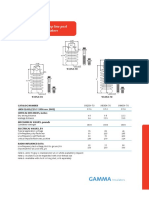59713609rvC OpManPXS5-926EA
59713609rvC OpManPXS5-926EA
Uploaded by
Calidad CocoCopyright:
Available Formats
59713609rvC OpManPXS5-926EA
59713609rvC OpManPXS5-926EA
Uploaded by
Calidad CocoOriginal Title
Copyright
Available Formats
Share this document
Did you find this document useful?
Is this content inappropriate?
Copyright:
Available Formats
59713609rvC OpManPXS5-926EA
59713609rvC OpManPXS5-926EA
Uploaded by
Calidad CocoCopyright:
Available Formats
Cover Sheet
OPERATION MANUAL 5971-3609 Rev. C
Model: PXS5-926EA Date: 10/12/00
ORIGINATOR: Jeff Wimsatt
Approved By: Date:
Revision Record
Rev Date Changes
50 10/12/00 Established per ECO 3255
A 11/13/00 Revised and Released per ECO 3264
B 10/12/06 Revised and Released per ECO 3810
ECO5405 - Added Data and Procedures from 5900-
5034, 5900-0034, 5900-0035, 5900-0062, & 5900-
C 1/4/18
0063 to this operation manual under section 8.
APPENDIX A, and Updated sheet paging numbers
OPERATION MANUAL
PXS5-926EA
Update Release
Revision C
5971-3609 Rev C, Page 1
TABLE OF CONTENTS
SECTION TITLE PAGE
1. INTRODUCTION 3
2. GENERAL DESCRIPTION 3
3. SPECIFICATIONS 3
3.1 X-RAY OUTPUT 3
3.2 MECHANICAL 4
3.3 ELECTRICAL 4
4. INSTALLATION AND OPERATION 6
4.1 UNPACKING AND INSPECTION 6
4.2 INTERCONNECTIONS 6
4.3 INSTALLATION 6
4.4 OPERATION 6
5. TEST PROCEDURES 7
6. CONDITIONING 8
7. SCHEMATIC, PXS5, CUSTOMER INTERFACE, 9
5971-0719
8. APPENDIX A 10
8.1 X-RAY SOURCE RUN-UP PROCEDURE 10
8.2 COLD RUN-UP TIME FOR INACTIVE 12
X-RAY SOURCES
8.3 WARNING, TUBE TEMP 13
8.4 MARTERIAL SAFTEY DATA SHEET 14
8.5 RADIATION SAFETY DATA SHEET 16
NOTES
1. THE X-RAY WINDOW ON THE SOURCE IS FABRICATED FROM BERYLLIUM FOIL.
THIS SHOULD BE HANDLED WITH CARE DUE TO ITS FRAGILITY AND DUE TO THE
TOXIC NATURE OF BERYLLIUM COMPOUNDS WHEN INTRODUCED INTO THE BODY.
5971-3609 Rev C, Page 2
1. INTRODUCTION
Kevex manufactures X-ray sources which are sold to customers as components for incorporation
into equipment for sale or for use within their own operations. These instructions are intended to
provide the equipment assembler with information needed for the installation, adjustment and
testing of the Kevex X-ray source when it is designed into the user's equipment. These
instructions also direct attention to some features of these sources which must be considered in
order to minimize the chance of accidental X-ray exposure to the equipment operators or to
nearby people. In most applications the design and operation of X-ray equipment must comply
with the requirements of governmental or other regulatory agencies. It is the assembler's
responsibility to ensure that equipment using this X-ray source is in compliance with the
appropriate regulations. In the USA information regarding US Government requirements may be
obtained from: Division of Radiological Products, Office of Compliance, Center for Devices and
Radiological Health, Food and Drug Administration, 8757 Georgia Avenue, Silver Springs,
Maryland 20910.
2. GENERAL DESCRIPTION
The x-ray source consists of a miniature microfocus x-ray tube combined with a high voltage
power supply in a single, compact, rugged package. The output intensity is adjustable by means
of customer supplied controls for beam voltage and current. The high voltage generator has a DC
output and is controlled by all solid state components. Complete line regulation of both the beam
voltage and current ensures stable x-ray production over the entire input voltage range (9-15
VDC). In addition, long service life is promoted by beam over-current protection (high voltage
decreases).
3. SPECIFICATIONS
3.1 X-RAY OUTPUT
3.1.1 X-RAY OUTPUT:
30 15% R/minute at 1 foot from the tube window when operated at 90kV, 8
watts. Measured with a Keithly 96035B ion chamber and 35050A readout.
3.1.2 FOCAL SPOT:
Less than 9 microns at 8 watts, 45kV-90kV.
Less than 5 microns at 4 watts, 55kV-90kV
3.1.3 X-RAY WINDOW:
Beryllium foil 127 microns thick.
3.1.4 X-RAY SHIELDING:
Integral x-ray shielding reduces the intensity of radiation leakage from the x-ray
source to 0.5 mR/hour or less measured 1 inch away from all housing surfaces
behind the tube mounting plate. Intensities in front of this plate, especially
within the cone of illumination, are much higher and an appropriately shielded
enclosure is required.
5971-3609 Rev C, Page 3
3.1.5 X-RAY CONE OF ILLUMINATION:
The x-rays emerge from the window in a cone with its apex located at the focal
spot. The total included solid angle is approximately 45o. In certain
applications, the user must provide an external collimator or beam defining
system to limit the area illuminated by x-rays.
3.1.6 X-RAY OUTPUT STABILITY:
+/- 3% from 15 minutes to 24 hr from 45 to 90kV, 4 to 8 watts. The source shall
be powered up for at least ½ hour prior to measurement. Measurement is with
a Keithly 96035B ion chamber and 35050A readout.
3.2 MECHANICAL
3.2.1 DIMENSIONS:
4.2"W x 11.6"L x 2.9"H (107mm x 277mm x 74mm) approx.
3.2.2 WEIGHT:
8 lbs. (3.7 kilograms) approx.
3.2.3 TEMPERATURE RANGE:
0 TO 32o C Ambient. During operation, the tube mounting plate temperature
must not be allowed to exceed 50o C. For long life and stable operation, it is
recommended to keep this temperature below 40o C. An external cooling fan is
required to ensure this for continuous duty operation.
3.3 ELECTRICAL
3.3.1 INPUT VOLTAGE:
12 +2 -1 VDC
3.3.2 INPUT CURRENT:
3.5 amps nominal at 12 VDC input at full power.
3.3.3 BEAM VOLTAGE:
Beam voltage is externally controlled over the range 0 to 90kV DC. The normal
range for in-focus operation is 45-90kV.
3.3.4 BEAM CURRENT:
The PXS5-926 includes a constant beam power feature. The beam current is
externally set to achieve the desired beam power level. But beam current is
internally adjusted by the programmed kV to maintain the programmed beam
power, limited to 8 watts. Thus, the beam current varies with kV; for example,
at 90 kV, the maximum current is 89 µA, and as kV is lowered, the maximum
current will increase to 178 µA at 45 kV. Beam current maximum is 180 µA.
5971-3609 Rev C, Page 4
3.3.5 OVERCURRENT PROTECTION:
The beam voltage will drop to a low value if the beam current exceeds 120%
of the programmed value.
3.3.6 BEAM VOLTAGE AND CURRENT MONITORS:
Voltages proportional to beam voltage and beam current are available for
remote indication of operating levels.
BEAM VOLTAGE MONITOR:
Scale factor is: 1.0 VDC = 20kV.
4.5 Volts 0.5% at 90kV.
BEAM CURRENT MONITOR:
Scale factor is: 1.0 VDC = 40uA.
4.5 Volts 1.5% at 180uA.
SOURCE IMPEDANCE:
1,000 Ohms 1%. Calibration is within specified limits when the impedance of
the external indicating meters is greater than 1 MOhm. Lower impedance
meters may be used if the voltage drop in the source impedance is taken into
account in specifying the meter full scale sensitivity.
3.3.7 BEAM VOLTAGE AND CURRENT CONTROL:
The PXS5-926 is intended to be used with external 1,000 ohm potentiometers
for control of beam voltage from 0 to 90 kV and beam current to achieve 0 to 8
watts. 89µA 1.5% at 90kV (8 watts). Alternatively, beam voltage and current
can be controlled by external voltage sources variable over the range 0 to 4.5
VDC. From 45 to 90kV, beam current can be programmed for up to 8 watts.
Below 45kV, beam current is limited to a maximum of 180uA.
3.3.8 ON-OFF CONTROL:
X-ray ON-OFF control is by switching the input power. Refer to customer
interface schematic, page 7. There are two switches shown, a standby and an
operate switch. When standby power is applied, the cathode heater is on and
the warm up time to allow normal operation is about 60 seconds. When the
operate power is applied, the beam voltage and current will increase to the
programmed values.
IF BOTH SWITCHES ARE USED, INSURE THAT THE STANDBY POWER IS
NEVER REMOVED BEFORE THE OPERATE POWER IS REMOVED, OR
DAMAGE TO THE X-RAY SOURCE WILL RESULT.
5971-3609 Rev C, Page 5
4. INSTALLATION AND OPERATION
4.1 UNPACKING AND INSPECTION
Inspect package exterior for evidence of shipping and handling damage. IF DAMAGE IS
DETECTED, A CLAIM WITH THE CARRIER SHOULD BE FILED IMMEDIATELY. DO
NOT DESTROY OR REMOVE ANY OF THE PACKING MATERIALS IN A DAMAGED
SHIPMENT. If no exterior damage is detected, proceed to carefully unpack the equipment.
Examine the unit for any signs of damage including leaked oil. Always use extreme care
when handling the source near the beryllium window.
If any damage is found, immediately contact Thermo Kevex X-Ray.
4.2 INTERCONNECTIONS
Refer to the customer interface schematic, page 7, for connections to the control
equipment. This drawing shows a simplified controller schematic which does not include
safety interlocks, warning devices, timers, key switches, indicator lights or other features
which may be required by applicable regulations or safety codes.
4.3 INSTALLATION
Install the source in its intended location or in a radiation shielded test box. The source
requires an external cooling fan to maintain a safe temperature for continuous duty
operation (see section 3.2.3). It is strongly recommended that the temperature of the
tube mounting plate be monitored on new installations to ensure safe operation.
4.4 OPERATION
Connect suitable meters to the voltage and current monitor terminals as shown on the
interface schematic, page 7. Set the beam voltage (kV) and beam current (µA) controls to
zero and apply the 12 VDC operate power. Raise the voltage control and then the current
control to about 20% of maximum. Check for radiation leaks from the shielded enclosure
with a survey meter. Progressively raise the beam voltage and current following the run-up
procedure (Section 6) checking for radiation leakage at each new level of operation. Add
additional shielding if leakage is excessive.
After this initial operation of the source, it is permissible to operate at maximum power.
However, it is not recommended to apply operate power with the controls set to their
maximum values. Even after conditioning the source, it is recommended to ramp the
beam voltage slowly, over a period of at least 30 seconds, to the desired operating
point, especially if the operating point is over 70 kV.
5971-3609 Rev C, Page 6
5. TEST PROCEDURES
If it is suspected that the x-ray source does not perform according to specifications, the following
evaluation procedure should be followed:
5.1 Install the unit in a shielded enclosure.
5.2 Apply 12 VDC standby power to the unit. Verify that the voltage control signal varies with
potentiometer setting up to 4.5 VDC maximum. Turn on the operate switch and verify the
beam current control signal varies with potentiometer setting up to 5 volts maximum. With
the controls set to maximum, check that the output at the voltage monitor terminals is 4.5
VDC and the output at the current monitor terminal is 2.25 VDC, measured with a high
impedance voltmeter. The total input current from the 12 VCD supplies should be about
3.5 amps. Measure the source output using an ion chamber such as is listed in the
specifications.
5.3 If any of the measurements in 5.2 are fluctuating, listen for a ticking sound which could
indicate that there is an electrical discharge in the x-ray tube. If ticking noises are audible,
repeat the run-up procedure (Section 6).
5.4 If the problem cannot be resolved, contact Thermo Kevex X-Ray for further assistance.
The x-ray source is not user repairable and no attempts should be made to dismantle the
unit or to adjust the internal pre-set controls.
5971-3609 Rev C, Page 7
6. CONDITIONING
An periodic conditioning (or run-up procedure) is required to ensure safe operation, maintain the
warranty and help prolong the life of the source. Increasing the target voltage in steps allows the
source to become high voltage "conditioned", which prevents arcing and damage to the source.
When operating a new source or one that has been idle for more than two days, begin with the
target voltage and tube current controls set at their minimum values, and take 10 to 15 minutes to
run the source up to full power. At each step in the run-up schedule below, first increase the beam
voltage and then the current, waiting at least the minimum time before proceeding to the next step.
IMPORTANT: WHEN RUNNING A SOURCE UP TO FULL POWER, ALWAYS BE ALERT TO
ANY ARCING. IF MORE THAN TWO ARCS ARE OBSERVED, DECREASE THE BEAM
VOLTAGE TO THE PREVIOUS STEP. THEN WAIT AT LEAST THE MINIMUM TIME, STEP THE
VOLTAGE BACK UP AND CONTINUE THE PROCEDURE, ALWAYS BEING ALERT TO ARCING
(an audible ticking sound will be produced when an arc occurs).
RUN-UP SCHEDULE
STEP % OF MAX kV % OF MAX mA MINIMUM TIME
1 20 0 1 MINUTE
2 40 10 1 MINUTE
3 60 30 2 MINUTES
4 80 50 2 MINUTES
5 90 70 3 MINUTES
6 100 100 3 MINUTES
Once the source has been fully conditioned, turning on x-rays with both the beam voltage and
current set to their maximum values is possible. However, the following guidelines are best kept in
mind when establishing your own operating routine.
1. If the source is to be used throughout the working day, continuous operation within
specified ratings will maintain the source at its normal operating temperature and minimize
warm-up drift.
2. Frequent on-off cycling to full power, is stressful to the source. This is especially true if x-
rays have been off for several hours or more. In this case, it is recommended to run a short
version of the run-up schedule above. For example, if x-rays have been off more than a
few hours, but less than 2 days, start the source at 50% of maximum kV and run it up to
full kV and mA over a 1 minute period.
3. Occasional arcs are inherent in x-ray equipment and should not cause alarm. However,
frequent arcing which cannot be stopped by repeating this run-up procedure is indicative of
a fault in the x-ray source.
4. The source is not focused below 45kV and operation with beam current below 20kV is not
recommended.
5971-3609 Rev C, Page 8
7. SCHEMATIC, PXS5, CUSTOMER INTERFACE
5971-3609 Rev C, Page 9
8. APPENDIX A
8.1 X-RAY SOURCE RUN-UP PROCEDURE
The purpose of the Run-Up Procedure is to safeguard and help prolong the life of the source. This
incremental approach to reaching the working voltage allows the source to completely condition itself
and prevent premature damage.
When operating a new source or one that has been idle for several days, increase the beam voltage
slowly, taking typically 15 minutes (or more, depending on the idle time) to reach the full rated voltage.
At the same time, raise the beam current slowly to its maximum value, alternating increases in Voltage
and current in a manner similar to the daily run-up.
IT IS UNLIKELY THAT THE SOURCE WILL ARC, BUT IF IT DOES (as indicated by an
audible ticking or jump in the kV and mA monitor levels), SHUT OFF THE HIGH VOLTAGE
AND WAIT A MINUTE, THEN RESTART THE RUN-UP AT A SLOWER RATE.
When a source is to be used several times during a working day, turn it on at the start of the day and
leave it running. This avoids frequent on-off cycling and has the added benefit of keeping the system
at its normal operating temperature, and minimizing warm-up drift. If practical, keep the source
running at two-thirds maximum voltage and one-fourth maximum current. If the source must be shut
down when a sample is changed, when restarting, raise the voltage and current back up slowly (30 to
60 seconds) to minimize stress to the source.
Even with a source in constant use, DO NOT TURN ON MAXIMUM VOLTAGE SUDDENLY.
Instead, switch the source on at one-half voltage, then take about 30 seconds to raise the voltage to its
maximum value. This can be done at normal source current.
When using a source with a filamentary electron gun, AVOID PROLONGED OPERATION AT
LESS THAN 5kV AND HIGH CURRENTS. The filament operating temperature under these
conditions is higher than normal, thus decreasing filament life expectancy.
Ensure that the source cooling system is performing adequately. This is particularly important since
the maximum allowable housing temperature typically is 50 o C. A good target for normal operating
temperature is <40° C.
Suggested daily run-up schedules for sources by kV range are given in the following graph (Page 11).
5971-3609 Rev C, Page 10
TIME TO REACH 100% OF For an example, take a source which is rated at 90kV,
MAXIMUM RATED kV AND mA: 0.089mA:
1. Look at chart on left to find that it should take 10
Max Rated kV TIME minutes to get full kV and mA.
50 10 minutes 2. Next, equate the 90kV and .089 mA to 100%.
70 10 minutes 3. A typical run-up would then follow the graph above.
90 10 minutes 50% time would equal 5 minutes. From the graph,
110 12 minutes 50% time equals 65% kV and mA, which would be
130 15 minutes 58.5 kV and .058 mA.
160 20 minutes
This is a general daily run-up schedule.
Always be alert to arcing and reduce Kv if any arcs are
noticed.
5971-3609 Rev C, Page 11
8.2 COLD RUN-UP TIME FOR INACTIVE X-RAY SOURCES
The following run-up times should be used for an x-ray source that has been left inactive
for an extended period of time.
Run-Up Time for X-Ray Sources with Maximum Operating Voltage up to:
Off Time 50kV 90kV 130kV
1 day 10 minutes 15 minutes 15 minutes
1 week 20 minutes 25 minutes 30 minutes
1 month 50 minutes 60 minutes 70 minutes
2 months 80 minutes 90 minutes 100 minutes
2-6 months 2 hours 3 hours 3 hours
over 6 months 3 hours 4 hours 4 hours
To bring the x-ray source to full power, follow the Kevex X-Ray “SOURCE RUN-UP
PROCEDURE”. For long inactive periods (in excess of 2 months) the recommended
run-up times should be considered a minimum. Great care should be taken to bring
inactive sources up to full voltage.
Recommended Operation During Storage
*An x-ray source held in storage should be operated periodically. We recommend that
the source be brought to full power (following the run-up procedure listed above)
monthly. The source should then be left operational in an appropriate radiation enclosure
for a period of one to two hours.
5971-3609 Rev C, Page 12
8.3 WARNING, TUBE TEMP
WARNING
During normal operation of KEVEX x-ray tubes, the temperature of the tube housing
should not be permitted to rise above 55o C. Operating temperatures in excess of this may
lead to instability of the x-ray output or premature tube failure.
Depending upon the ambient temperature within the equipment using the tube and the
tube operating duty cycle, this may require the use of a fan or blower with its output
directed at the tube housing.
No KEVEX x-ray tube should be exposed to harsh chemical environments that could
result in window corrosion and premature tube failure.
Any liquid cooled tube or power supply that is returned to the factory for any reason must
have all cooling lines purged of glycol or similar coolants, by flushing them with water.
5971-3609 Rev C, Page 13
8.4 MATERIAL SAFETY DATA SHEET
October 1, 1996
SECTION I - PRODUCT IDENTIFICATION
This x-ray tube uses a beryllium x-ray window.
SECTION II - BERYLLIUM MANUFACTURER
Brush Wellman, Inc., 14710 W. Portage River S. Road, Elmore, OH 43416-9502
24-Hour Emergency Assistance: (800) 862-4118
SECTION III - HAZARDOUS INGREDIENTS
Beryllium Metal: The x-ray window is made of 100% beryllium metal.
SECTION IV - PHYSICAL DATA BERYLLIUM
Appearance: Varies in color from a grey metallic to a dull
greyish red solid
Odor: None
Atomic Weight: 9.01
Melting Point: 1278 + 5oC
Boiling Point at 1 ATM: 2970oC
Solubility: N/A
Specific Gravity at 20o: 1.85
Vapor Pressure: N/A
SECTION V - FIRE AND EXPLOSION HAZARD DATA
Beryllium will ignite at approximately 1200oF. Since the amount of
beryllium used is very small, use a fire-fighting agent or media
appropriate for the surrounding fire.
Flash Point: NE Lower Flammable Limit: NE
Upper Flammable Limit: NE Auto-Ignition Temperature: 1200oF
NE = NOT ESTABLISHED
SECTION VI - HEALTH HAZARD
Effects of Over Exposure:
Inhalation of beryllium particles may cause berylliosis, a serious
chronic lung disease, with cough, chest pain, shortness of breath,
weight loss, weakness, and fatigue.
5971-3609 Rev C, Page 14
MSDS - BERYLLIUM
First Aid:
If exposed or if cut by beryllium, remove from area and consult a
physician. Handling of solid shapes presents no dermatitis or skin
absorption problem.
Potential Carcinogen:
Beryllium is a material which has been listed, principally on animal
tests, as a potential carcinogen in the International Agency for Cancer
Research Monograph Series and the National Toxicology Program Annual
Report on Carcinogens identifying it as a potential cancer hazard.
SECTION VII - REACTIVITY DATA
Oxidation will form on solid shapes when moist. Beryllium with acids
may generate hydrogen. Moisture will corrode beryllium and may dissolve
through the window in a matter of days.
SECTION VIII - SPILL AND DISPOSAL PROCEDURES
Beryllium metal scrap, and chips are normally recycled. However, in
cases where this is not justified, solid material may be landfilled.
If a beryllium window breaks, cover the open part with plastic and tape
in place. Wear gloves. Pick up small pieces of beryllium with the
sticky side of the tape. These small amounts of beryllium may be
disposed of in a landfill as mentioned above.
SECTION IX - SPECIAL PROTECTION INFORMATION
Do not touch the beryllium window, it is extremely fragile and can be
toxic. Because of toxicity, it is recommended as a precaution that if
the window is accidentally touched you immediately wash your hands with
soap and water.
SECTION X - MISCELLANEOUS INFORMATION
The above information is believed to be accurate and represents the best
information currently available to us. However, because we do not
manufacture the beryllium metal or the beryllium x-ray windows, we make
no warranty of merchantability or any other warranty expressed or
implied with respect to such information, and we assume no liability
resulting from its use. Users should make their own investigations to
determine the suitability of the information for their particular
purposes.
See Kevex X-Ray "Radiation Safety Data Sheet" for information regarding
radiation hazards.
5971-3609 Rev C, Page 15
8.5 RADIATION SAFETY DATA SHEET
SECTION I - PRODUCT IDENTIFICATION
X-ray tubes and portable x-ray sources.
SECTION II – MANUFACTURER
Thermo Fisher Scientific
320 El Pueblo Road
Scotts Valley, CA 95066
Telephone:(831) 438-5940
SECTION III – HAZARDS
X-Ray radiation is a form of ionization radiation that is potentially very hazardous. The most intense and
therefore dangerous part of the instrument is the path of the incident X-ray beam. Thus care should always be
exercised to know the expected path of the incident beam. Scattered radiation is typically of such reduced
intensity that it poses a much smaller health risk to the researcher.
There are several properties of X-Rays that make this type of radiation particularly dangerous to use in the
laboratory. X-Ray radiation cannot be sensed by a human! Some people feel a tingling sensation on their skin
when they are around X-Rays from an analytical instrument. They are not feeling the X-ray beams, but rather
they are feeling charged air particles produced by the interaction of the ionizing X-Rays with air. If you ever
feel a tingling sensation when working around any analytical X-Ray instrument, immediately turn off the
instrument and contact the Radiation Safety Officer (RSO). Since only some people feel this tingling
sensation, do not assume that if the sensation is not present, that the instrument cannot hurt you. Please note
that the two shutters on the instrument are interlocked to the cabinet doors so that if either door is opened, the
shutters should close.
Care should be taken when using any analytical X-ray instrument. Never put any part of your body in the
expected path of the main beam. Avoid being around the X-Ray tube housing and main beam path as much
as possible. Keep the enclosure doors closed whenever possible.
Although X-ray instruments have the potential to be dangerous; when used properly, modern diffraction X-
ray instruments pose few risks to careful users. The manufacture and use of analytical X-ray instruments is
regulated by both federal and state governments. Current regulations require that a variety of safety devices
be built into X-ray instruments that make it very difficult for anyone to even accidentally expose herself or
himself to the dangerous incident X-ray beam. The design of the instruments limits even accidental
exposures to the hands, arms, and facial areas. Generally, the types of radiation used in diffraction
instruments (primarily Mo and Cu Kα radiation) are considered soft or low energy radiation. Unlike medical
X-Rays, these types of soft radiation generally will not penetrate more than 2-4 cm into the body.
SECTION IV - HEALTH HAZARDS
ALARA, As Low As Reasonably Achievable, goals are also achieved by the user practicing safe techniques
when using the X-Ray instrument. As noted above, the user should keep all parts of their body out of the
expected main beam path at all times, especially when placing a sample in the instrument or removing a
sample from the instrument. When the safety enclosure is opened, the user should keep as far from the X ray
source as practical. Finally, the cabinet doors should be kept closed whenever possible.
Health effects of exposure to X-ray radiation come in two general types, direct or indirect. X Rays are
thought to create radicals in exposed cells of your body that may break or modify chemical bonds within
critical biological molecules. As a result (1) cells may be injured or damaged, although many cells repair
5971-3609 Rev C, Page 16
themselves, resulting in no residual damage, (2) cells may die, which millions of body cells do every day and
are replaced in a normal biological process, (3) or cells may incorrectly repair themselves resulting in a
biophysical change. Finally, X-Rays may pass through the body with no interaction.
Factors that determine biological effects:
Dose rate
Total dose received
Energy of the radiation
Area of the body exposed
Individual sensitivity
Cell sensitivity
Most sensitive tissues: Blood-forming organs, reproductive organs, digestive organs
Least sensitive tissues: Nervous system, muscle and connective tissues
Studies indicate that the risk of cancer in children increases if the mother is exposed to significant X-radiation
during pregnancy. The State of California and other Agreement States have established an exposure limit of
5000 millirems per year for occupationally exposed adults. Because the effect of radiation may be greater on
an unborn child, the radiation dose limit recommended for them is 500 millirems. Women who are pregnant
or expect to become pregnant soon may wish to consider the effect of radiation on their unborn children.
SECTION V - PRECAUTIONS
Each of the following steps must be followed for personnel and equipment safety:
-Insure that portable sources are securely anchored. Tubes should be anchored securely in a
radiation proof enclosure with appropriate lead shielding. X-rays can scatter off objects and
thus get around corners.
-Operate only when window is in an x-ray shielded chamber.
-Chamber access doors must be interlocked to prevent x-ray tube operation
with the doors open.
-The beryllium window is fragile and toxic if scratched, do not subject the window to
mechanical pressures.
-User must provide adequate shielding in the window area.
-The vacuum tube is glass and therefore fragile; do not drop mishandle and/or drop.
-Ground the tube mounting surface.
5971-3609 Rev C, Page 17
-Check the high voltage cables for frays or damage.
-Never kink or sharply bend the high voltage cable as it is used to supply a ground on the tube
which, without proper grounding, is a lethal hazard.
SECTION VI - OCCUPATIONAL DOSE LIMITS
The State of California (see California Radiation Control Regulations, Title 17, California Administrative
Code, Section 30265), and other Agreement States, have established maximum dose limits for individuals
working in a radiation area. These limits have been established on a calendar quarter basis, but they may be
expressed on a yearly, monthly, and hourly basis (assuming 40 hours of exposure per week for 50 weeks per
year). The limits are as follows:
Body Part Rems/CalQuarter Rems/Year Millirems/Mo Millirems/Hr
Whole Body 1.25 5 417 2.5
Hands/Forearms/
Feet/Ankles 18.75 75 6,250 37.5
Skin of Whole Body 7.5 30 2,500 15
Differences in limits for different body parts are a direct consequence of the differences in their sensitivities to
radiation. Hands, as an example, are considerably less sensitive to radiation than the body as a whole.
Your safety governing body may have different occupational dose limits. Please see your Radiation Safety
Officer, RSO, for more information.
SECTION VII - BIOLOGICAL EFFECTS OF RADIATION
A complete description of the various effects of radiation is outside the scope of this document. Among the
documented biological effects of radiation are various types of cancers, blood diseases, weakened bones,
sterility, hearing problems, teeth loss, hair loss, digestive troubles, and skin burns. Radiation nonspecifically
damages cells and tissues and can have both cancerous and non-cancerous effects.
SECTION VIII - EMERGENCY PROCEDURES
In case of a disaster such as fire, explosion, flooding, or earthquake, the X-Ray equipment must be de-energized
immediately. Once de-energized, the x-ray equipment poses no radiation danger. After a disaster the X-Ray
equipment must be surveyed before placing it back in operation. The proper approach for operation of X-Ray
equipment is to perform the surveys at each power setting as the X-Ray equipment power is increased in a step
by step manner from no power to maximum power.
SECTION IX - MISCELLANEOUS INFORMATION
This document serves as a source of basic radiation safety information for users of Thermo Fisher Scientific
X-ray equipment. However, these guidelines are not to be used in lieu of any regulations specified by your
officially recognized regulatory authorities (i.e., U.S. Dept. of Health and Human Services, Food and Drug
Administration).
5971-3609 Rev C, Page 18
You might also like
- Onsite Travel Policy - V 2.1Document15 pagesOnsite Travel Policy - V 2.1Harsh GuptaNo ratings yet
- Rebooting India Realizing A Billion Aspirations (Nilekani, Nandan Shah, Viral)Document396 pagesRebooting India Realizing A Billion Aspirations (Nilekani, Nandan Shah, Viral)athul jobyNo ratings yet
- Instruction Book Qc1112 and Qc2112 ESF 2960 0380 00 ENDocument79 pagesInstruction Book Qc1112 and Qc2112 ESF 2960 0380 00 ENКонстантин Гетьман100% (1)
- X-Ray Tube Assembly & Installation ManualDocument72 pagesX-Ray Tube Assembly & Installation ManualĐăng Lê Hồ Nguyên100% (1)
- M-sr-130 Rev 6 Ul - sn413 - XXXDocument38 pagesM-sr-130 Rev 6 Ul - sn413 - XXXIM100% (1)
- 85watt Photovoltaic Module: PerformanceDocument2 pages85watt Photovoltaic Module: PerformancerevleNo ratings yet
- RW Pipe CalculationDocument5 pagesRW Pipe Calculationrangarajan100% (1)
- Project Report On Pavement DesignDocument50 pagesProject Report On Pavement Designsagar kumar100% (1)
- 59715601rvB OpManPXS5-925RRDocument19 pages59715601rvB OpManPXS5-925RRCalidad CocoNo ratings yet
- 59713608rvD OpManPXS5-925EADocument19 pages59713608rvD OpManPXS5-925EACalidad CocoNo ratings yet
- 59714602rvC - OPMANPXS5 822 822WBDocument19 pages59714602rvC - OPMANPXS5 822 822WBCalidad CocoNo ratings yet
- 59718608rva OpMan822-HRDocument10 pages59718608rva OpMan822-HRCalidad CocoNo ratings yet
- Amprobe ACF3000 AK: AC Current ProbeDocument63 pagesAmprobe ACF3000 AK: AC Current ProbetrebeardNo ratings yet
- Vmax/A: Medium Voltage Vacuum Circuit Breaker Ansi: 4.76kV-15 KV 1200-2000 A 31.5 KaDocument35 pagesVmax/A: Medium Voltage Vacuum Circuit Breaker Ansi: 4.76kV-15 KV 1200-2000 A 31.5 KaSreepriodas RoyNo ratings yet
- Color TV Service ManualDocument49 pagesColor TV Service ManualAnirudha Mhase100% (4)
- Stamford Ucdi274kDocument7 pagesStamford Ucdi274kSilver SilverNo ratings yet
- EMERSON Y COMPAÑIA - Trupper ETV20Document36 pagesEMERSON Y COMPAÑIA - Trupper ETV20ponchomaresNo ratings yet
- SidePower RCT-23E (RemoteControl)Document20 pagesSidePower RCT-23E (RemoteControl)Alexander DamaskinosNo ratings yet
- 1260 ManualDocument215 pages1260 ManualGaurav AcharyaNo ratings yet
- UCI274H 25 TD EN - Rev - BDocument8 pagesUCI274H 25 TD EN - Rev - Bteja sri rama murthyNo ratings yet
- CT720g S774AAR5S2NCDocument45 pagesCT720g S774AAR5S2NCAnonymous CJnGHNNo ratings yet
- 21FL84 CH - GA4Document33 pages21FL84 CH - GA4DanielSaniNo ratings yet
- MVR1600 4601 ADocument7 pagesMVR1600 4601 AzinouNo ratings yet
- P228-Ixs080bp056p228 Rev 3Document8 pagesP228-Ixs080bp056p228 Rev 3tao zhangNo ratings yet
- ASC-4 Data Sheet 4921240529 UKDocument11 pagesASC-4 Data Sheet 4921240529 UKmohammad alhajNo ratings yet
- Ucdi274k 311 TD en Rev BDocument9 pagesUcdi274k 311 TD en Rev Bkaleabb2121No ratings yet
- Sharp 21FL91 Chasis GA2Document46 pagesSharp 21FL91 Chasis GA2calvariusNo ratings yet
- 2-Installation and Maintenance ManualDocument14 pages2-Installation and Maintenance ManualEric ChienNo ratings yet
- Hanwha SolarOne's SF220 PDFDocument2 pagesHanwha SolarOne's SF220 PDFKirsten HernandezNo ratings yet
- Daewoo DTQ 29u1scDocument65 pagesDaewoo DTQ 29u1scIrving CarvajalNo ratings yet
- Regulador Avc63-4 Basler ElectricDocument4 pagesRegulador Avc63-4 Basler ElectricJose Manuel Bautista MartinezNo ratings yet
- HCM434E - Winding 27: Technical Data SheetDocument7 pagesHCM434E - Winding 27: Technical Data SheetRenzo zuñiga ahonNo ratings yet
- Ucm274h 14 TD en Rev ADocument7 pagesUcm274h 14 TD en Rev Ateja sri rama murthyNo ratings yet
- HCI434E/444E - Winding 25: Technical Data SheetDocument8 pagesHCI434E/444E - Winding 25: Technical Data SheetRenzo zuñiga ahonNo ratings yet
- Service Manual: Color Television Chassis No. SN-010Document27 pagesService Manual: Color Television Chassis No. SN-010victor lobascioNo ratings yet
- Daewoo CM-405F DTH-2930SSFVDocument54 pagesDaewoo CM-405F DTH-2930SSFVMarco Antonio100% (3)
- Service Manual: Color Television Chassis No. MSADocument28 pagesService Manual: Color Television Chassis No. MSAVerkis HernandezNo ratings yet
- UCI274G 17 TD EN - Rev - BDocument7 pagesUCI274G 17 TD EN - Rev - Bsierra67_lee3476No ratings yet
- Service Manual TV Sharp 29fl94Document40 pagesService Manual TV Sharp 29fl94ppstone67% (6)
- PANASONIC TX-21AT2P (CP-521P) (WWW - Pieseelectronice.net)Document17 pagesPANASONIC TX-21AT2P (CP-521P) (WWW - Pieseelectronice.net)tipudelacablutvNo ratings yet
- Datasheet Alternador Hci544e1 PDFDocument8 pagesDatasheet Alternador Hci544e1 PDFDilham BerrioNo ratings yet
- Daewoo CM-101S DTH-21S7, DTH-21S8Document58 pagesDaewoo CM-101S DTH-21S7, DTH-21S8Marco Antonio100% (8)
- Oi Kcap300-En eDocument20 pagesOi Kcap300-En ejaime HernandezNo ratings yet
- 26MR70Document28 pages26MR70jotas2525No ratings yet
- Cbip 88Document14 pagesCbip 88Sai Kanth100% (1)
- Chassis CM-405F Manual de ServicioDocument54 pagesChassis CM-405F Manual de ServicioEdgar Orellana M.No ratings yet
- Chassis CM-405F Manual de Servicio PDFDocument54 pagesChassis CM-405F Manual de Servicio PDFanthoni timaureNo ratings yet
- Table5168b 411Document2 pagesTable5168b 411khemrajmahadewNo ratings yet
- Installation Manual of 525Document63 pagesInstallation Manual of 525Wajaht Ali100% (1)
- S310 OpManIssue3Document24 pagesS310 OpManIssue3service3397No ratings yet
- Analog Dialogue Volume 46, Number 1: Analog Dialogue, #5From EverandAnalog Dialogue Volume 46, Number 1: Analog Dialogue, #5Rating: 5 out of 5 stars5/5 (1)
- Reference Guide To Useful Electronic Circuits And Circuit Design Techniques - Part 2From EverandReference Guide To Useful Electronic Circuits And Circuit Design Techniques - Part 2No ratings yet
- Influence of System Parameters Using Fuse Protection of Regenerative DC DrivesFrom EverandInfluence of System Parameters Using Fuse Protection of Regenerative DC DrivesNo ratings yet
- Offshore Wind Energy Generation: Control, Protection, and Integration to Electrical SystemsFrom EverandOffshore Wind Energy Generation: Control, Protection, and Integration to Electrical SystemsNo ratings yet
- On-Chip Electro-Static Discharge (ESD) Protection for Radio-Frequency Integrated CircuitsFrom EverandOn-Chip Electro-Static Discharge (ESD) Protection for Radio-Frequency Integrated CircuitsNo ratings yet
- Static-Inverter 1.0: A Complete Design Process to Convert D.C. to A.C. Electricity Using the Astable-MultivibratorFrom EverandStatic-Inverter 1.0: A Complete Design Process to Convert D.C. to A.C. Electricity Using the Astable-MultivibratorNo ratings yet
- Introduction to Power System ProtectionFrom EverandIntroduction to Power System ProtectionRating: 5 out of 5 stars5/5 (1)
- Reference Guide To Useful Electronic Circuits And Circuit Design Techniques - Part 1From EverandReference Guide To Useful Electronic Circuits And Circuit Design Techniques - Part 1Rating: 2.5 out of 5 stars2.5/5 (3)
- Critical Issues in High Cycle Fatigue PDFDocument11 pagesCritical Issues in High Cycle Fatigue PDFeankiboNo ratings yet
- 2SP0115T Control IGBT ManualDocument21 pages2SP0115T Control IGBT Manualhieuhuech1No ratings yet
- Pre-Sedimentation Tank Effects On Water Treatment Unit OperationDocument9 pagesPre-Sedimentation Tank Effects On Water Treatment Unit OperationMiguel A'ngelNo ratings yet
- Impact of Social MediaDocument7 pagesImpact of Social MediaVikram SahaNo ratings yet
- Msds Npk01 August 2013Document7 pagesMsds Npk01 August 2013Ardhy LazuardyNo ratings yet
- Pip CVC01015-2019Document25 pagesPip CVC01015-2019antonio diaz100% (1)
- Introduction To Wing DesignDocument9 pagesIntroduction To Wing DesignJef LeNo ratings yet
- Common Issues of BGPDocument7 pagesCommon Issues of BGPPranavNo ratings yet
- P020D-Fuel Injector 4 Performance: Theory of OperationDocument2 pagesP020D-Fuel Injector 4 Performance: Theory of OperationWillie AustineNo ratings yet
- Study of Hydrogen Fuel Cell TechDocument59 pagesStudy of Hydrogen Fuel Cell TechKalyanam ANo ratings yet
- (PC) Yonai v. Teaford Et Al - Document No. 3Document2 pages(PC) Yonai v. Teaford Et Al - Document No. 3Justia.comNo ratings yet
- Market Chain Analysis of Teff (Eragrostistef) : The Case of Dejen District, East Gojam Zone, EthiopiaDocument73 pagesMarket Chain Analysis of Teff (Eragrostistef) : The Case of Dejen District, East Gojam Zone, EthiopiabojaNo ratings yet
- 9335X 70Document1 page9335X 70Nia SilviharyaniNo ratings yet
- JOINT PIT Type 1Document2 pagesJOINT PIT Type 1annasNo ratings yet
- Chapter 1 & Chapter 2 Sosiologi Tahap IDocument11 pagesChapter 1 & Chapter 2 Sosiologi Tahap ICitraNo ratings yet
- Waterproofing Sika Waterbar PVC Waterstops en - MYDocument12 pagesWaterproofing Sika Waterbar PVC Waterstops en - MYNusaibah YusofNo ratings yet
- 2002-2004, Belanak FPSO - Juare97's Blog Berbagi Pengalaman & PengetahuanDocument7 pages2002-2004, Belanak FPSO - Juare97's Blog Berbagi Pengalaman & PengetahuanwidiNo ratings yet
- Exploratory Research Design: Qualitative ResearchDocument27 pagesExploratory Research Design: Qualitative ResearchPrakash Sharma100% (3)
- Pecs Self-Rating Questionnaire Corrected Score SheetDocument2 pagesPecs Self-Rating Questionnaire Corrected Score SheetPrincess Faniega SugatonNo ratings yet
- Behaviour of Plate Anchorage in Plate-Reinforced Composite Coupling BeamsDocument13 pagesBehaviour of Plate Anchorage in Plate-Reinforced Composite Coupling BeamsTamir EnkhNo ratings yet
- Ias-33 EpsDocument59 pagesIas-33 Epssyed asim shahNo ratings yet
- SM10LZ47-Triac ToshibaDocument3 pagesSM10LZ47-Triac ToshibanegrusrlNo ratings yet
- Objective Type Question Bank (GATE and PSU)Document5 pagesObjective Type Question Bank (GATE and PSU)hytNo ratings yet
- Fabm 1-PTDocument12 pagesFabm 1-PTMaxene YbañezNo ratings yet
- Management Structure Indofood CBPDocument2 pagesManagement Structure Indofood CBPdwihitaNo ratings yet
- Design Review of Gas Insulated and Hybrid Gas Insulated SwitchgearDocument7 pagesDesign Review of Gas Insulated and Hybrid Gas Insulated SwitchgearshaswatNo ratings yet

























































































